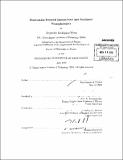| dc.contributor.advisor | John D. Joannopoulos and Steven G. Johnson. | en_US |
| dc.contributor.author | Rodriguez-Wong, Alejandro | en_US |
| dc.contributor.other | Massachusetts Institute of Technology. Dept. of Physics. | en_US |
| dc.date.accessioned | 2011-05-09T15:14:54Z | |
| dc.date.available | 2011-05-09T15:14:54Z | |
| dc.date.copyright | 2010 | en_US |
| dc.date.issued | 2010 | en_US |
| dc.identifier.uri | http://hdl.handle.net/1721.1/62653 | |
| dc.description | Thesis (Ph. D.)--Massachusetts Institute of Technology, Dept. of Physics, 2010. | en_US |
| dc.description | Cataloged from PDF version of thesis. | en_US |
| dc.description | Includes bibliographical references (p. 293-329). | en_US |
| dc.description.abstract | We present theoretical and numerical methods for studying Casimir forces and nonlinear frequency conversion in nanophotonic media consisting of arbitrary geometries and materials. The first section of the thesis focuses on the study of various geometry-enabled resonant effects leading to strong nonlinear interactions. The starting point of this work is a coupled-mode theory framework for modeling a wide range of resonant nonlinear frequency-conversion processes in general geometries, ameliorating the need for repeated and expensive finite-difference time-domain simulations. We examine the predictions of the theory for two particular nonlinear processes: harmonic generation and difference-frequency generation. Our results demonstrate strong enhancement of nonlinear interactions at a "critical" input power leading to 100% frequency conversion, among many other interesting dynamical effects. Using a quantum-mechanical description of light, based on cavity quantum electrodynamics, similar enhancement effects are demonstrated at the single-photon level, leading to the possibility of achieving all-optical switching of a single signal photon by a single gating photon in a waveguide-cavity geometry consisting of pumped four-level atoms embedded in a cavity. Finally, we describe how one may tailor the geometry of certain materials to enhance their nonlinear susceptibilities by exploiting a consequence of the Purcell effect. The second section of the thesis, the main contribution of this work, presents a new formulation for studying Casimir forces in arbitrary geometries and materials that directly exploits efficient and well-developed techniques in computational electromagnetism. To begin with, we present the step-by-step conceptual development of our computational method, based on a well-known stress tensor formalism for computing Casimir forces. A proof-of- concept finite-difference frequency-domain implementation of the stress-tensor method is described and checked against known results in simple geometries. Building on this work, we then describe the basic theoretical ingredients of a new technique for determining Casimir forces via antenna measurements in tabletop experiments. This technique is based on a (derived) correspondence between the complex-frequency deformation of the Casimir frequency-integrand for any given geometry and the real-frequency classical electromagnetic response of the same geometry, but with dissipation added everywhere. This correspondence forms the starting point of a numerical Casimir solver based on the finite-difference time-domain method, which we describe and then implement via an off-the-shelf time-domain solver, requiring no modifications. These numerical methods are then used to explore a wide range of geometries and materials, of various levels of complexity: First, a four-body piston-like geometry consisting of two cylinders next to adjacent walls, which exhibits a non-monotonic lateral Casimir force (explained via ray optics and the method of images); Second, a zipper-like, glide-symmetric structure that leads to a net repulsive force arising from a competition between attractive interactions. Finally, we examine a number of geometries consisting of fluid-separated objects and find a number of interesting results. These include: stable levitation and suspension of compact objects, dispersion-induced orientation transitions, and strong non-zero temperature Casimir effects. | en_US |
| dc.description.statementofresponsibility | by Alejandro Rodriguez-Wong. | en_US |
| dc.format.extent | 329 p. | en_US |
| dc.language.iso | eng | en_US |
| dc.publisher | Massachusetts Institute of Technology | en_US |
| dc.rights | M.I.T. theses are protected by
copyright. They may be viewed from this source for any purpose, but
reproduction or distribution in any format is prohibited without written
permission. See provided URL for inquiries about permission. | en_US |
| dc.rights.uri | http://dspace.mit.edu/handle/1721.1/7582 | en_US |
| dc.subject | Physics. | en_US |
| dc.title | Fluctuation-induced interactions and nonlinear nanophotonics | en_US |
| dc.type | Thesis | en_US |
| dc.description.degree | Ph.D. | en_US |
| dc.contributor.department | Massachusetts Institute of Technology. Department of Physics | |
| dc.identifier.oclc | 713659583 | en_US |
